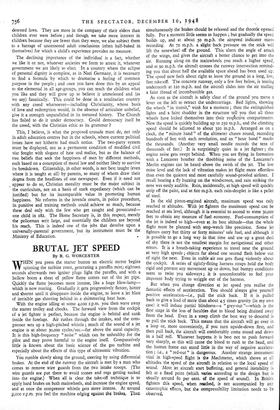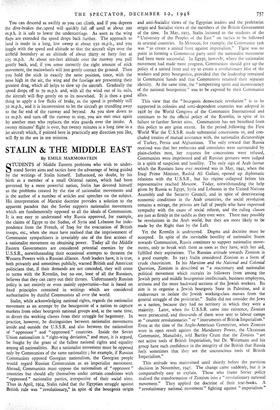BRUTAL JET SPEED
By R. G. WORCESTER
WHEN you press the starter button an electric motor begins spinning the turbine rotor, generating a paraffin mist; eighteen seconds afterwards two igniter plugs light the paraffin, and with a hollow boom a sheet of yellow flame comes out of the jet pipe. Quickly the flame becomes more intense, like a huge blow-lamp- which is now roaring. Gradually it gets progressively fiercer, hotter and shorter until it disappears inside the engine, to leave a jet blast of invisible gas shooting behind in a shimmering heat haze.
With the engine idling at some 4,000 r.p.m. you then wave away the starter trolley and chocks. The forward view from the cockpit of a jet fighter is perfect, because the engine is behind and sunk inside the fuselage. Air rushes through the intakes, and the com- pressor sets up a high-pitched whistle ; much Of the sound of a jet engine is at about 3o,000 cycles/sec.—far above the aural capacity. It is this high-frequency " noise " which can be unhealthy .for the pilot and may prove harmful to the engine itself. Comparatively little is known about the basic science of the gas turbine and especially about the effects of this type of ultrasonic vibration.
You rumble slowly along the ground, steering by using differential brakes. At the end of the runway the aircraft is met by a man who comes to remove wire guards from the two intake scoops. (The wire guards are put there to avoid stones and rags getting sucked into the engine.) When all is clear the take-off technique is to apply hard brakes on both mainwheels, and increase the engine speed, and at once the compressor whistle gets more intense. At around 9,000 r.p.m. you feel the machine edging against the brake*. Then
simultaneously the brakes should be released and the throttle opened fully. For a moment little seems to happen ; but gradually the speed builds up, and at about 5o m.p.h. the airspeed indicator starts recording. At 70 m.p.h. a slight back pressure on the stick will lift the nosewheel off the ground. This alters the angle of attack of the wings, and gives the aircraft a better chance to get into the air. Running along on the mainwheels you reach a higher speed, and at go m.p.h. the aircraft crosses the runway intersection remind- ing you that about half the available space ahead has been used up. The speed now feels about right to leave the ground in a long, low, fast take-off. The concrete runway, only a few feet below, is tearing underneath at 120 m.p.h. and the aircraft slides into the air trailing a faint thread of incombustible gas.
As soon as the aircraft is safely clear of the ground you move a lever on the left to retract the undercarriage. Red lights, showing the wheels " in transit," wink for a moment ; then the extinguished lights and a faint shudder in the structure tell you that all three wheels have locked themselves into their respective compartments. Now the speed is quickly building up to 25o m.p.h., and the climbing speed should be adjusted to about 320 m.p.h. Arranged as on a clock, the " minute hand" of the altimeter chases round, recording hundreds of feet with each revolution, and an " hour hand " marks the thousands. (Another very small needle records the tens of thousands of feet.) It is surprisingly quiet in a jet fighter ; the engine noise gets swept behind. When you are flying in formation with a Lancaster bomber the throbbing noise of the Lancaster's Merlin engines can be heard above the swish of the jet. The low noise level and the lack of vibration makes jet flight more effortless than even the quietest and most carefully sound-proofed airliner. I recall hearing a fly buzzing on the windscreen, and rain striking the nose was easily audible. Rain, incidentally, at high speed will quickly strip off the paint, and at 60o m.p.h. each rain-droplet is like a pellet of steel.
In the old piston-engined aircraft, maximum speed was only reached at altitudes. With jet fighters the maximum speed can be reached at sea level, although it is essential to ascend to some 30,000 feet to obtain any measure of fuel economy. Fuel-consumption of the jet is indeed so high—even at its best altitude—that the whole flight must be planned with stop-watch like precision. Some jet fighters carry but thirty or forty minutes' safe fuel, and although it is possible to go a long way in that time and use up a great deal of sky there is not the smallest margin for navigational and other errors. It is a breath-taking experience to travel near the ground at very high speeds ; objects far ahead one second flash below out of sight the next. Even in stable air one gets flung violently about the cockpit. A series of tightly-fitting harness straps hold the body rigid and prevent any movement up or down, but bumpy conditions seem to twist you sideways ; it is uncomfortable to feel your impotent body trying to wriggle out of the harness.
But when you change direction at jet speed you realise the fantastic effects of acceleration. You should always give yourself positive acceleration—i.e., pull the stick back. If it is pulled back to give a load of more than about 4.5 times gravity (in my own case) it will induce partial blindness—a " grey-out "—which is the first stage in the loss of faculties due to blood being drained away from the head. Even in a steep climb the best way to descend is to pull the stick back. This means that the aircraft will go over in a loop or, more conveniently, if you turn upside-down first, and then pull back, the aircraft will comfortably come round and down in a half roll. Whatever happens it is best not to push forward very sharply, as this will cause the blood to rush to the head, and the human frame can stand little in the way of negative accelera- tion ; i.e., a " red-out" is dangerous. Another strange instrument vital in high-speed flight is the Machmeter, which shows at all altitudes the speed of the aircraft in relation to the local speed of sound. Most jet aircraft start buffeting, and general instability is felt at a fixed point (which varies according to the design but is usually around 8o per cent. of the speed of sound). In British fighters this speed, when reached, is not accompanied by any catastrophic effects, but the compressibility limitation needs to be observed.
You can descend as swiftly as you can climb, and if you depress the dive-brakes the speed will quickly fall off until at about 200 m.p.h. it is safe to lower the undercarriage. As soon as the wing flaps are extended the speed drops back further. The approach to land is made in a long, low sweep at about iso m.p.h., and you juggle with the speed and altitude so' that the aircraft slips over the airfield boundary at an altitude of about thirty or forty feet at 125 m.p.h. At about ten-feet altitude over the runway you pull gently back, and, if you sense correctly the right amount of stick movement, the mainwheels will just gently contact the ground. Then you hold the stick in exactly the same position, since, with the nose high in the air, the wing and the fuselage are presenting their greatest drag, which all helps to slow up the aircraft. Gradually the speed drops off to 70 m.p.h. and, with all the wind out of its sails, the aircraft will flop gently on to its nosewheel. It is then a good thing to apply a few flicks of brake, as the speed is probably still 5o m.p.h., and it is inconvenient to let the aircraft go trundling away to the far end of the runway and beyond. As you slow down to to m.p.h. and turn off the runway to stop, you are met once again by another man who replaces the wire guards over the intake. A twenty minutes' flight is over, but twenty minutes is a long time in a jet aircraft which, if pointed here in practically any direction you like, will fly to the sea in ten minutes.















































 Previous page
Previous page